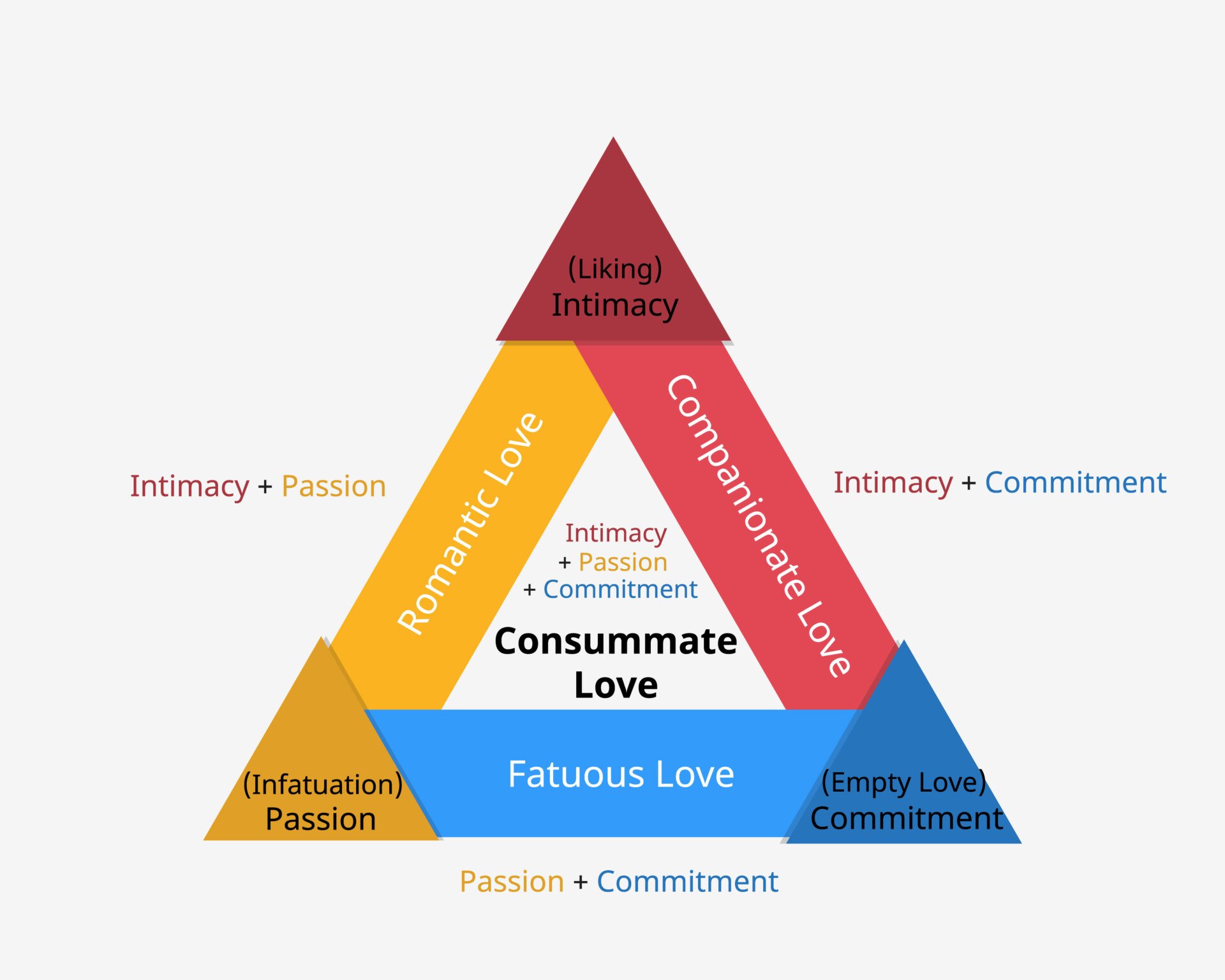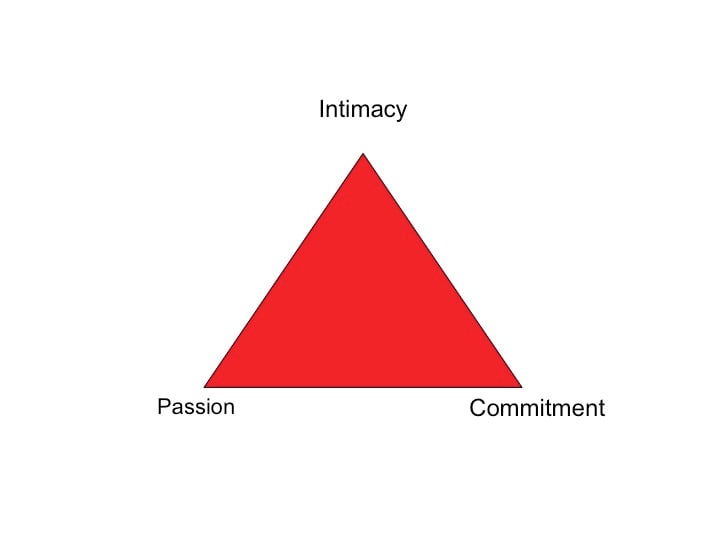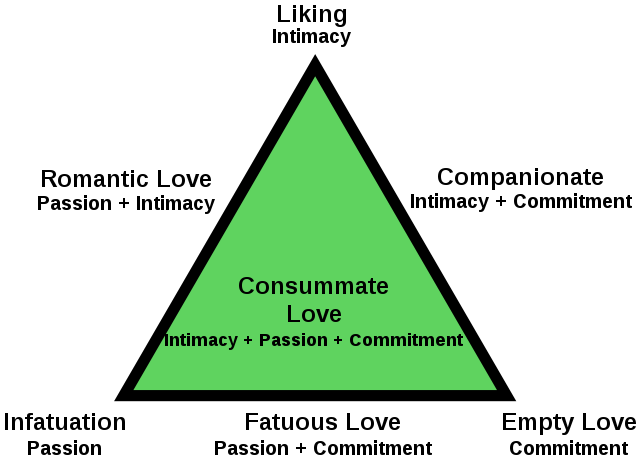On This Page:
Take-home Messages
- Robert Sternberg’s triangular theory of love is a theory that proposes three components of love, which combine in different ways to create eight kinds of love (Sternberg, 1986).
- The three components of love in the triangular theory of love are intimacy, passion, and decision/commitment (Sternberg, 1986).
- According to Sternberg, these three components of love combine to create eight kinds of love: nonlove, liking, infatuated love, empty love, romantic love, companionate love, fatuous love, and consummate love (Sternberg, 1986).

Robert Sternberg introduced his theory of love in a 1986 paper titled “A triangular theory of love” (Sternberg, 1986). This article will lay out the fundamental ideas of his theory discussed in this paper.
Three Components of Love
Within Sternberg’s triangular theory of love, he explains that there are three components of love:
- Intimacy: the closeness each partner feels to the other and the strength of the bond that binds them together. Partners high in intimacy like value and understand their partners.
- Passion: based on romantic feelings, physical attraction, and sexual intimacy with the partner.
- Decision/Commitment: represents cognitive factors such as acknowledging that one is in love and committed to maintaining the relationship.
According to Sternberg, these components are fundamental to what love is and interact in different ways to create various kinds of love (Sternberg, 1986).

Intimacy
Sternberg defines the intimacy component of love as “feelings of closeness, connectedness, and bondedness in loving relationships,” including “those feelings that give rise, essentially, to the experience of warmth in a loving relationship” and “largely, but not exclusively, deriving from emotional investment in the relationship” (Sternberg, 1986, p. 119).
The intimacy component of love typically remains stable over time, is somewhat able to be controlled, and people’s awareness of it tends to fluctuate, meaning that sometimes people are aware of these types of feelings towards others but sometimes they are not aware that they are experiencing intimate feelings (Sternberg, 1986).
The intimacy component plays a medium role in short-term relationships but plays a larger role in long-term relationships (Sternberg, 1986).
This component of love also tends to cause a moderate psychophysiological response in people (Sternberg, 1986).
Passion
Sternberg defines the passion component of love as “the drives that lead to romance, physical attraction, sexual consummation, and related phenomena in loving relationships.” This includes “those sources of motivational and other forms of arousal that lead to the experience of passion in a loving relationship,” and it’s largely, although not exclusively, derived from “motivational involvement in the relationship” (Sternberg, 1986, p. 119).
Aspects of the passion component of love are usually unstable and often change (Sternberg, 1986). People are usually not able to control whether or not these feelings are present in a relationship. Still, they tend to be aware of whether or not they are experiencing these types of feelings toward someone (Sternberg, 1986).
The passion component of love tends to have a large role in short-term relationships and only a medium role in long-term relationships (Sternberg, 1986).
This component tends to cause a high psychophysiological response in people (Sternberg, 1986).
This psychophysiological response tends to be more short-term, as our bodies cannot sustain a heightened psychophysiological state for extended periods of time.
Decision/Commitment
Finally, Sternberg defines the decision/commitment component of love as “in the short term, the decision that one loves someone else, and in the long term, the commitment to maintain that love.”
Commitment includes “the cognitive elements that are involved in decision making about the existence of and potential long-term commitment to a loving relationship” and “deriving largely, although not exclusively, from cognitive decision in and commitment to the relationship” (Sternberg, 1986, p. 119).
Like the intimacy component of love, the decision/commitment component also typically remains stable over time, and people’s awareness of it tends to fluctuate throughout time (Sternberg, 1986).
However, the decision/commitment component of love is more easily controlled than the intimacy component (Sternberg, 1986).
The decision/commitment component tends to play a very small part if any part, in short-term relationships and a large part in long-term relationships (Sternberg, 1986).
This makes sense, as it would be difficult to continue a relationship for a significant period of time without some sort of subconscious commitment to that person and the relationship overall.
8 Types of Love
According to Sternberg (1986), the 3 components (intimacy, passion, commitment) are fundamental to what love is and interact in different ways to create 8 types of love.

Relationships can become unbalanced if there is too great an investment in one component rather than the others or if one component is missing, such as romantic love (missing commitment) or companionate love (missing passion).
According to the theory, “true” (i.e., consummate) love is achieved when all three components are achieved.
Nonlove
The first type of love that Sternberg introduces is nonlove, which is when none of the three components of love are present in a relationship (Sternberg, 1986).
According to Sternberg, nonlove can be seen in the “casual interactions” in our everyday lives and actually “characterizes the large majority of our personal relationships” (Sternberg, 1986, p. 123).
These relationships and interactions contain a complete lack of love, as none of the components of love are involved. This makes sense, as people would not typically express any sort of feelings of love for any brief encounter in their lives.
Liking (also called friendship)
The second type of love that Sternberg introduces is liking, which is when the intimacy component of love is present in a relationship, but the passion and decision/commitment components are not (Sternberg, 1986).
According to Sternberg, liking involves feelings of “closeness, bondedness, and warmth toward the other, without feelings of intense passion or long-term commitment” (Sternberg, 1986, p. 123).
Liking can be seen in the relationships in our lives that we refer to as friendships (Sternberg, 1986).
As we all know, friendships can exist at different levels, and according to Sternberg, if any other components of love are present in a friendship, then it is not considered liking but is considered a different kind of love (Sternberg, 1986).
Therefore, only friendships that lack the passion and decision/commitment components of love are considered to be the kind of love labeled as liking.
Infatuation
The third type of love that Sternberg introduces is infatuated love, which is when the passion component of love is present in a relationship, but the intimacy and decision/commitment components are not (Sternberg, 1986).
Sternberg’s Fatuous Love is a type of love that combines Passion (physical and romantic attraction) and Commitment (decision to maintain the relationship) but lacks Intimacy (deep connection and understanding). This love type is often characterized by whirlwind romances driven by passion but lacking true depth.
Sternberg places “love at first sight” in this category of love, which according to him, involves “a high degree of psychophysiological arousal, manifested in somatic symptoms such as increased heartbeat or even palpitations of the heart, increased hormonal secretions, erection of genitals (penis or clitoris), and so on” (Sternberg, 1986, p.124).
This kind of love develops very quickly, without time for any intimate feelings to grow or for a commitment to be made (Sternberg, 1986).
Empty Love
The fourth type of love that Sternberg introduces is empty love, which is when the decision/commitment component of love is present in a relationship, but the intimacy and passion components are not (Sternberg, 1986).
This type of love can commonly be found in some long-term relationships where the couple has lost feelings for one another.
However, Sternberg points out an interesting phenomenon regarding this kind of love: “In our society, we are most accustomed to empty love as it occurs as a final or near-final stage of a long-term relationship,” but “in other societies, empty love may be the first stage of a long-term relationship” (such as in an arranged marriage) (Sternberg, 1986, p. 124).
Romantic Love
The fifth type of love that Sternberg introduces is romantic love, which is when the intimacy and passion components of love are present in a relationship, but the decision/commitment component is not (Sternberg, 1986).
This kind of love can also be thought of as “liking with an added element, namely, the arousal brought about by physical attraction and its concomitants” (Sternberg, 1986, p. 124).
For a popular literary example of this kind of love, one can look at “Romeo and Juliet,” where the couple shares both intimate and passionate feelings towards one another but have made no real commitment to one another (Sternberg, 1986, p. 124).
Romantic love can also be found towards the beginning of some long-term relationships before the involved parties have committed to a long-term relationship with the other person.
Companionate Love
The sixth type of love that Sternberg introduces is companionate love when the intimacy and decision/commitment components of love are present in a relationship, but the passion component is not (Sternberg, 1986).
Sternberg’s Consummate Love refers to the ideal form of love that combines three components: Intimacy (deep connection and understanding), Passion (physical and romantic attraction), and Commitment (the decision to maintain love in the long term). It’s considered the most complete and balanced form of love.
Sternberg describes this type of love as “a long-term, committed friendship, the kind that frequently occurs in marriages in which the physical attraction (a major source of passion) has died down” (Sternberg, 1986, p. 124).
Because marriages typically involve such large amounts of the intimacy and decision/commitment components of love, they can often become forms of companionate love when the “spark” or the passion in the relationship is lost, commonly over time (Sternberg, 1986).
Fatuous Love
The seventh type of love that Sternberg introduces is fatuous love, which is when the passion and decision/commitment components of love are present in a relationship, but the intimacy component is not (Sternberg, 1986).
According to Sternberg, fatuous love “is the kind of love we sometimes associate with Hollywood, or with whirlwind courtships, in which a couple meets on Day X, gets engaged two weeks later, and marries the next month”, where “a commitment is made on the basis of passion without the stabilizing element of intimate involvement” (Sternberg, 1986, p. 124).
Because the intimate component of love takes time to develop, these relationships lack that aspect of love and their relationship may therefore be more likely to fail (Sternberg, 1986).
Consummate Love
Finally, the eighth type of love that Sternberg introduces is consummate love, which is when all three components of love are present in a relationship (Sternberg, 1986).
Nowadays, when one thinks of love, they are most likely thinking about consummate love. Additionally, consummate love is seemingly the type of love that most people aim to find (Sternberg, 1986).
Outside of romantic interests, an example of consummate love can be found in many parents” love for their children, often dubbed “unconditional love” (Sternberg, 1986).
Related Research
In 1999, researchers Lemieux and Hale provided support for Sternberg’s theory of triangular love with their study of undergraduates, in which they found that the three components of love were “significantly related to a measure of Relational Satisfaction” (Lemieux & Hale, 1999, p. 497).
The next year, in 2000, they conducted a similar study, this time with married participants, and also found “that each component was a significant predictor of relational satisfaction” (Lemieux & Hale, 2000, p. 941).
In 2009, researcher Deverich conducted a study regarding Sternberg’s triangular theory of love to discover whether or not adolescents could be in consummate love according to Sternberg’s theory (Deverich, 2009).
Interestingly, she found that “due to their inconsistencies in fulfilling Sternberg’s viewed loving components…adolescents are not capable of being consummately in love” (Deverich, 2009, p. 21).
References
Deverich, S. (2009). Love unveiled: Teenage love within the context of Sternberg’s triangular theory of love. Intuition, 5, 21-25.
Lemieux, R., & Hale, J. L. (1999). Intimacy, passion, and commitment in young romantic relationships: Successfully measuring the triangular theory of love. Psychological reports, 85 (2), 497-503.
Lemieux, R., & Hale, J. L. (2000). Intimacy, passion, and commitment among married individuals: Further testing of the triangular theory of love. Psychological Reports, 87 (3), 941-948.
Sternberg, R. J. (1986). A triangular theory of love. Psychological review, 93 (2), 119.
Sternberg, R. J. (1987). Liking versus loving: A comparative evaluation of theories. Psychological Bulletin, 102 (3), 331.

